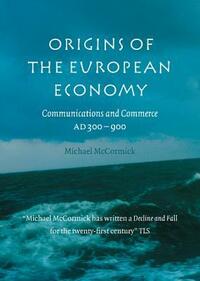Take a photo of a barcode or cover
2 reviews for:
Origins of the European Economy: Communications and Commerce A.D. 300-900
Michael McCormick
2 reviews for:
Origins of the European Economy: Communications and Commerce A.D. 300-900
Michael McCormick
challenging
informative
fast-paced
The Dark Ages, until recent decades, was one of the most poorly understood eras of European history. It is a period bracketed by the Roman Empire and the High Middle Ages. The dearth of written resources has made it difficult for historians to piece together the nature of the period on traditional methods. Michael McCormick innovated an approach, building on the research of others, to shed a great deal of light on what Europe's economy looked like.
There has been two competing visions for what Europe's economy was between 300 and 1000 CE. On one hand some argue that Christian Europe entered freefall as long-distance trade and communication while other historians said that trade continued in great volume during the period. McCormick forges a different, more nuanced path. In short, he argues that there were periods of decline and growth. Following the fall of the Roman Empire their patterns of trade and connectivity declined. Long-distance, subsidized trade collapsed as did the markets in Rome and elsewhere. The nadir appears to have occurred in the 7th century. It makes sense as Muslim conquests were disrupting North Africa and the Levant. However, around 750 trade began to revive, though it never died. Old routes returned. Trade journeys shifted from long-distance to shorter legs, improvements in technology and trade practices stitched together parts of the Mediterranean and Northern Europe.
McCormick's tome is extensive and looks at many different facets of communications and trade over the period. The logs of diplomats, pilgrims, and missionaries show evidence that links frayed but never broke, the appearance of foreign coins in Italy and France suggests engagement with Islamic trade, and the appearance of goods from far and wide appear in hordes and royal halls.
The European economy underwent a particular set of transformations. First was the decline of Rome and its network of trade. Byzantium kept part of the network in tact in the Eastern Mediterranean and Southern Italy, but invading tribes disrupted much of Europe. The imperial network ceased to function, but the rise of Islam and Charlemagne created a new market. The German and French territories transformed from a wild frontier to an imperial centre and therefore a growing demand for luxury goods of the Mediterranean over the Alps. McCormick suggests that the growth of cities like Venice are due in part to Europeans supplying slaves to Muslim markets.
Generally it is established that the year 1000 is the beginning of the restoration of trade with the rise of the Italian maritime republics. McCormick clearly demonstrates that these cities had an early advantage centuries before hand supplying the prosperous markets of Egypt, and Syria. Not to mention that while there is a low point there is a definite continuity. As stability returned, or was established in Europe new and greater trade links developed through the Balkans, Eastern Europe, etc. McCormick does a fantastic job providing strong evidence that trade continued and insight to the 'Dark Ages'. It helped shape my understanding of the period and though I don't have the expertise I found it accessible and well-written.
There has been two competing visions for what Europe's economy was between 300 and 1000 CE. On one hand some argue that Christian Europe entered freefall as long-distance trade and communication while other historians said that trade continued in great volume during the period. McCormick forges a different, more nuanced path. In short, he argues that there were periods of decline and growth. Following the fall of the Roman Empire their patterns of trade and connectivity declined. Long-distance, subsidized trade collapsed as did the markets in Rome and elsewhere. The nadir appears to have occurred in the 7th century. It makes sense as Muslim conquests were disrupting North Africa and the Levant. However, around 750 trade began to revive, though it never died. Old routes returned. Trade journeys shifted from long-distance to shorter legs, improvements in technology and trade practices stitched together parts of the Mediterranean and Northern Europe.
McCormick's tome is extensive and looks at many different facets of communications and trade over the period. The logs of diplomats, pilgrims, and missionaries show evidence that links frayed but never broke, the appearance of foreign coins in Italy and France suggests engagement with Islamic trade, and the appearance of goods from far and wide appear in hordes and royal halls.
The European economy underwent a particular set of transformations. First was the decline of Rome and its network of trade. Byzantium kept part of the network in tact in the Eastern Mediterranean and Southern Italy, but invading tribes disrupted much of Europe. The imperial network ceased to function, but the rise of Islam and Charlemagne created a new market. The German and French territories transformed from a wild frontier to an imperial centre and therefore a growing demand for luxury goods of the Mediterranean over the Alps. McCormick suggests that the growth of cities like Venice are due in part to Europeans supplying slaves to Muslim markets.
Generally it is established that the year 1000 is the beginning of the restoration of trade with the rise of the Italian maritime republics. McCormick clearly demonstrates that these cities had an early advantage centuries before hand supplying the prosperous markets of Egypt, and Syria. Not to mention that while there is a low point there is a definite continuity. As stability returned, or was established in Europe new and greater trade links developed through the Balkans, Eastern Europe, etc. McCormick does a fantastic job providing strong evidence that trade continued and insight to the 'Dark Ages'. It helped shape my understanding of the period and though I don't have the expertise I found it accessible and well-written.
